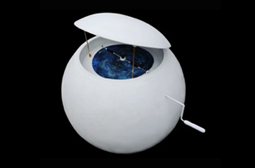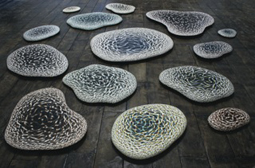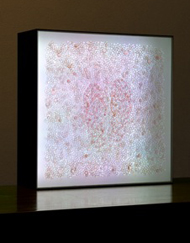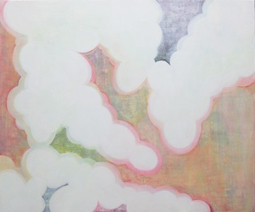 |
Focus features two in-depth reviews each month of fine art, architecture and design exhibitions and events at art museums, galleries and alternative spaces around Japan. The contributors are non-Japanese art critics living in Japan. |
|
|
 |
 |
 |
DanDans Does Bulgari
Lucy Birmingham |
 |
 |
|
 |
| Mihoko Ogaki, "Star Tales - Greek Myths," 2010, mixed media, W850 H850 D850 mm |
|
Mayumi Okabayashi, "overflow," 2010, wood, acrylic paint, dimensions variable |
Kazuko Aso says she's just a housewife with a long-time interest in art. But you would know this isn't true after one look at the latest exhibition produced by DanDans, the contemporary art cooperative she founded in 2005. It's the seventh annual show she's organized -- non-profit and all-volunteer -- with members from among the 100 or so emerging artists in the group. Titled "The Lounge," it features curated works by 20 artists, showing at the intimate eighth floor lounge of the Bulgari flagship store in Ginza until January 27.
DanDans' aim is to support young artists in Japan not yet represented by a gallery. Every year since its 2005 launch, the group has held a themed exhibition to introduce selected works by its member artists. The yearly theme and artworks are chosen by the DanDans organizers and professional art curators.
During the exhibitions, visitors can purchase the work through a silent auction. In keeping with the spirit of the project, 70-90% of the purchase price goes to the artists. The remaining amount goes into a fund kept for the next exhibition.
"As an art lover," says Aso, "I was inspired to start DanDans after learning that young emerging artists cannot afford central Tokyo's high-cost rental gallery spaces and that gallery representation is very difficult to secure here." Tokyo rental galleries normally require a 50/50 sales split or a rental fee that can amount to thousands of dollars for a one- or two-week show.
At first, Aso simply introduced young artists to places where they could easily exhibit. But then the word spread and interest blossomed. A group exhibition seemed like the next best step.
The first, called "The Shop," was held in August 2005 at a former tailor shop in Ginza and featured 15 artists. The second show, "What about Black and White?", took place in February 2006 at Gallery Concept 21 in Aoyama, with 14 artists. The third exhibition, "Le Monde de Coco," was held in August 2007 at Nexus Hall in the Ginza Chanel Building with 23 artists presenting works inspired by Madame Chanel and her life. By this time, word had gotten out that the DanDans artists were a dynamic and serious group. About 3,000 visitors came, and once again, most of the works were sold.
The fourth exhibition, "The House," took place in May 2008 in a group of four model homes located in Roppongi, with 57 artists chosen by nine curators. The exhibition attracted about 2,600 visitors and was featured on TV and in other media. The ambitious pace continued with a fifth exhibition, "Midsummer Dream," held in August 2009 at the elegant Chinzan-so (Four Seasons Hotel). Three curators chose the 61 artists, and the visitor count exceeded 3,200. For 2010, 36 DanDans artists, chosen by one curator, participated in an historic group exhibition titled "No Man's Land" at the former French Embassy. Thousands of visitors came, and the exhibition was widely covered by the international media.
"The exhibitions are not just a chance for artists to show and sell their work," says Aso. "It's also an opportunity to interact with visitors and explain their work. I've found that many young Japanese artists are shy about expressing themselves. So I strongly urge them to become more outgoing, to practice promoting themselves and their work."
Exhibiting artists are required to participate in the show's preparation. They also must deliver their work directly to the buyers. This helps to create or strengthen an artist/collector relationship by adding a personal touch to the purchase and an opportunity for further exchange.
The DanDans name is derived from the Japanese character dan or "group" and the French word dans, meaning "in." Being "in" DanDans has its advantages, but the goal is for the artists to secure gallery representation so they can "graduate" from the group.
So far, DanDans has helped launch or escalate the careers of about 200 artists. Many have been discovered by gallerists visiting the shows. Some, like sculptor Ikki Miyake, who participated in the 2007 Chanel show, have watched their careers take off. In 2009, he had a work auctioned at Christies for five million yen. Painter Yasushi Ebihara is another example. "I bought one of Ebihara's works in 2006 for 150,000 yen when he was having a very hard time selling," says Aso. "Now his works are selling for ten times that amount." Ebihara first showed with DanDans in 2006 at the Gallery Concept 21 exhibition and then "graduated" in 2007 after the Chanel show.
The theme for "The Lounge" Bulgari show is "colors," inspired by the brand's exquisite jewelry. Artist Yu Shinomiya has blended some of these colors and jewels in his performance installation "trace (cross-wiring)" -- a collaboration with pianist Azusa Suzuki, composer Teruaki Suzuki, and synesthete Noriko Nagata, who is gifted with the neurological ability to visualize colors with certain sounds. By assigning musical notes to the colors of jewels embedded in a 1965 Bulgari necklace and earrings set -- turquoise, amethyst, and two versions of emerald green -- they were able to create the very original composition for piano solo titled "Pigment du son." While performing, Suzuki's fingers -- dipped in powders of the chosen colors -- leave a fascinating visual trace showing the colors that correspond to each note and key.
Other highlights include a moon-shaped orgel (wind-up music box) titled "Star Tales - Greek Myths" by Mihoko Ogaki. A paper cylinder painted like the cosmos and punched with holes forms the pretty music that she says invokes the sounds of Greek myths. Mayumi Okabayashi's "overflow" reflects her interest in energy vibrations. She has been based in Germany since 1997. Yuka Namekawa was also an expat in London for several years, partially on an artist's grant from Japan's Ministry of Culture. She explains that her work "My traffic light 1 / My traffic light 2" focuses on people's judgment processes and their reactions based on prejudices. Her time abroad has clarified her thoughts about Japanese artists in Japan and their risk-averse approach. "We are not making modern art but contemporary art, which means that we must express opinions or anger," she explains. "It's important for artists to challenge themselves and show their work in many different locations to as many different kinds of people as possible."
"Japan's art market is very limited," says Aso. "At the DanDans shows several years ago we got more Chinese and Korean collectors. The number of foreign collectors is shrinking so it's important for Japanese artists to exhibit abroad. The key is being invited to join a gallery that will show at the international art fairs."
With Aso's remarkable commitment, determination, and A-lister connections (she's a member of one of Japan's most powerful families), DanDans artists have an unusual and inspiring advantage.
 |
|
 |
Yuka Namekawa, "My traffic light 1," 2010, acrylic sheet, polyethylene, LED light, W450 H450 D150 mm
|
|
|
|
Chisato Tanaka, "City of Light," 2010, oil and acrylic on canvas, W410 H320 D20 mm |
|
 |
|
|
Akiko Setoguchi, "tayutau," 2010, panel, acrylic, chalk, colored pencil, W727 H606 D25 mm
All images courtesy of DanDans
|
|
|
 |
 |
Lucy Birmingham
Based in Japan for almost 25 years, Lucy Birmingham has written for Newsweek, Bloomberg News, Architectural Digest, The Boston Globe, Artinfo.com, Artforum.com, and ARTnews, among other publications. As a photojournalist her work has appeared in The New York Times, Business Week, Forbes, Fortune, U.S. News and World Report, and A Day in the Life of Japan. She is also a scriptwriter and contributing editor at NHK, Japan's public broadcaster, and has published several books including Old Kyoto: A Guide to Traditional Shops, Restaurants, and Inns. |
|
 |
|